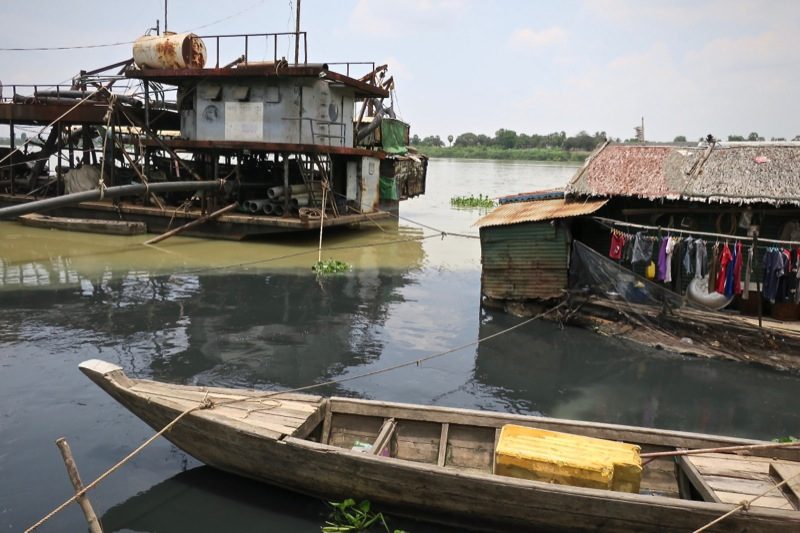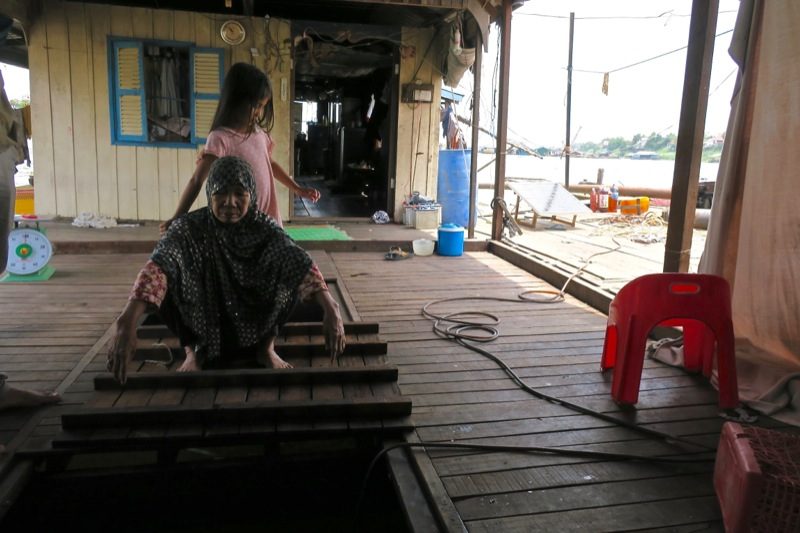Hundreds of floating houses have been snaking down the Tonle Sap river to central Phnom Penh over the past few days, fleeing what one boat owner described on Tuesday as an influx of sewage that killed a massive amount of fish.
“All the fish died, and the water turned smelly and black,” said Mann Ream, 65, who has been farming fish in cages beneath her floating house since 1979, when she relocated to Phnom Penh’s Kilometer 7 neighborhood in Russei Keo district. “It smelled like sewage.”

Towed by boats, the flotilla of wooden houses has been slowly making its way along the river since Sunday. As Ms. Ream and dozens of other fish farmers who also live above their stock guided their homes under the Chroy Changva bridge on Tuesday at lunchtime, hundreds of people crowded against the railing and along the riverbanks to watch and take photographs of the unusual sight.
For Ms. Ream, the trip downriver has been a costly inconvenience.
When her fish started dying on Sunday, Ms. Ream could have lost up to 6 million riel, or about $1,500. She saved hundreds of dollars by selling the already-dead fish for a little less than half the price of live fish.
Sewage has killed the farmers’ fish stocks before, and the hundreds of families who farm in the Tonle Sap at Kilometer 7 used to guide their homes downstream once every few years, according to Ms. Ream, who estimated between 200 and 300 floating houses had joined the latest exodus.
But the problem has grown worse in the past three or four years as the capital has expanded and sewage treatment systems have failed to keep pace. In recent years, boat owners have had to move two or three times a year due to fish deaths, sometimes for several days at a time, Ms. Ream said.
According to Taber Hand, a researcher who has studied fisheries on the Tonle Sap and Mekong River for more than 20 years, fish deaths like this are often the result of untreated sewage being pumped into the river.
“The black water sucks out oxygen because of the high biological oxygen demand” of microbes that feed on the sewage, Mr. Hand said. The problem is exacerbated after heavy rains flood the city’s sewage systems, pushing their contents into waterways, he said.
When black water began seeping under her home on Sunday, Ms. Ream suspected the most recent flush of sewage came from 2 km north of the boat’s usual spot, in Svay Pak commune.

Reporters who visited the riverbank in Svay Pak on Tuesday saw a stream of black water, about 5 meters wide, that smelled strongly of sewage. It flowed between wooden homes raised on stilts, making its way directly into the Tonle Sap. A pool of black water formed where the stream met the river before it faded into a greenish-blue hue.
Residents in the area said the stream and sewage smell was a constant in the neighborhood.
“The smell gets worse when it floods in Phnom Penh,” said Sok Pov, 30, sitting on a bench a few hundred meters from the raw sewage. “It’s been going on for three or four years.”
Agriculture Ministry spokesman Lord Reaksmey also laid blame on untreated sewage and suggested City Hall address the problem.
“There should not be bad water flowing into the river,” Mr. Reaksmey said. “Our brothers and sisters use it for drinking and cooking, so City Hall should take measures on that.”
Contacted on Tuesday, a City Hall spokesman told a reporter to call back later and then did not answer his telephone again.
As the city’s sewage system is placed under more and more pressure, fish deaths are likely to worsen, according to Mr. Hand, which is bad news for fish farmers like Ms. Ream.
For now, she said she would take her boat further south to near the Royal Palace, though she didn’t know how long she would have to stay there before being able to return to her home.
“We’ll go back when the water is not poisoned,” she said.




